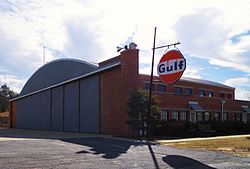Tuskegee Airmen National Historic Site: Difference between revisions
→History: rewritten |
→References: edited and expanded |
||
| Line 51: | Line 51: | ||
==References== |
==References== |
||
{{Portal box|United States Air Force|Military of the United States|World War II}} |
|||
{{reflist}} |
|||
{{AFHRA}} |
|||
{{Reflist}} |
|||
* Shaw, Frederick J. (2004), Locating Air Force Base Sites History’s Legacy, Air Force History and Museums Program, United States Air Force, Washington DC, 2004. |
|||
* Manning, Thomas A. (2005), History of Air Education and Training Command, 1942–2002. Office of History and Research, Headquarters, AETC, Randolph AFB, Texas ASIN: B000NYX3PC</ref> |
|||
==External links== |
==External links== |
||
Revision as of 13:19, 11 July 2012
Tuskegee Airmen National Historic Site Moton Field | |
 The Hangar One Museum at The Tuskegee Airmen National Historic Site at Moton Field in Tuskegee, Alabama | |
| Location | Tuskegee, Alabama, USA |
|---|---|
| Coordinates | 32°27′33″N 085°40′48″W / 32.45917°N 85.68000°W |
| Built | 1940 |
| Architect | U.S. Army |
| NRHP reference No. | 10,323 |
| Significant dates | |
| Added to NRHP | November 6, 1998 |
| Designated NHLD | November 6, 1998 |
Tuskegee Airmen National Historic Site, at Moton Field in Tuskegee, Alabama, commemorates the contributions of African American airmen in World War II. Moton Field was the site of primary flight training for the pioneering pilots known as the Tuskegee Airmen. It was constructed in 1941 as a new training base. The field was named after former Tuskegee Institute principal Robert Russa Moton, who died the previous year.
History

Moton Field was the only primary flight facility for African-American pilot candidates in the U.S. Army Air Corps (Army Air Forces) during World War II. It was named for Robert Russa Moton, second president of Tuskegee Institute. [1]
Moton Field was built between 1940-1942 with funding from the Julius Rosenwald Fund to provide primary flight training under a contract with the U.S. military. Staff from Maxwell Field, Montgomery, Alabama, provided assistance in selecting and mapping the site. Architect Edward C. Miller and engineer G. L. Washington designed many of the structures. Archie A. Alexander, an engineer and contractor, oversaw construction of the flight school facilities. Tuskegee Institute laborers and skilled workers helped finish the field so that flight training could start on time.[1]
The Army Air Corps assigned officers to oversee the training at Tuskegee Institute/Moton Field. They furnished cadets with textbooks, flying clothes, parachutes, and mechanic suits. Tuskegee Institute, the civilian contractor, provided facilities for the aircraft and personnel, including quarters and a mess for the cadets, hangars and maintenance shops, and offices for Air Corps personnel, flight instructors, ground school instructors, and mechanics. Tuskegee Institute was one of the very few American institutions to own, develop, and control facilities for military flight instruction.[1] In addition to the flight training at Moton Field, the following known sub-bases and auxiliaries were used:
- Calabee Flight Strip
- Hardaway Auxiliary Field
- Kennedy Auxiliary Field
After pilot cadets passed primary flight training at Moton Field, they transferred to Tuskegee Army Air Field (TAAF) to complete their training with the Army Air Forces. TAAF was a full-scale military base (albeit segregated) built by the U.S. military. The facility at Moton Field included two aircraft hangars, a control tower, locker building, clubhouse, wooden offices and storage buildings, brick storage buildings, and a vehicle maintenance area.[1]
Moton Field was closed in 1946. In 1972, a large portion of the air field at Moton Field was deeded to the city of Tuskegee for use as a municipal airport which is still in use today.[1]
National historic site
Established on November 6, 1998, the National Historic Site was placed on the National Register of Historic Places the same day. The site has a temporary visitor center. Hangar One has been restored and the grand opening [2] of the site was October 10, 2008. The Hangar One Museum is open for tours Wednesday-Sunday.[3] Tours are free of charge to the public.
An oral history project, consisting of interviews of hundreds of people involved in the Tuskegee Experience, was completed in 2005 and will eventually be available to the public.
References
![]() This article incorporates public domain material from the Air Force Historical Research Agency
This article incorporates public domain material from the Air Force Historical Research Agency
- Shaw, Frederick J. (2004), Locating Air Force Base Sites History’s Legacy, Air Force History and Museums Program, United States Air Force, Washington DC, 2004.
- Manning, Thomas A. (2005), History of Air Education and Training Command, 1942–2002. Office of History and Research, Headquarters, AETC, Randolph AFB, Texas ASIN: B000NYX3PC</ref>
External links
- Tuskegee Airmen National Historic Site, from the National Park Service
- Legends of Tuskegee, from the National Park Service
- Aviation: From Sand Dunes to Sonic Booms, from the National Park Service
- Tuskegee Airmen
- Tuskegee Airmen
- National Register of Historic Places in Macon County, Alabama
- Black history in the United States military
- Protected areas of Macon County, Alabama
- National Historic Sites in Alabama
- World War II airfields in the United States
- Aviation in the United States
- Aerospace museums in Alabama
- African American museums in Alabama
- Military and war museums in Alabama
- Museums in Tuskegee, Alabama
- Protected areas established in 1998
- African-American history of Alabama
- Alabama geography stubs
- Southern United States protected area stubs
- National Park Service stubs


